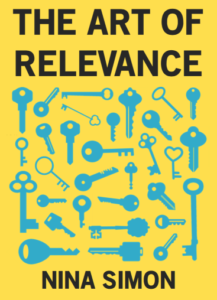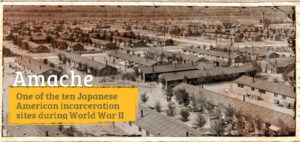This post was originally published as an assignment for INFO 200 Information Communities at the School of Information at San José State University.
Simon, N. (2016). The art of relevance. Santa Cruz: Museum 2.0.

The Art of Relevance. Nina Simon
Nina Simon served as the Executive Director of the Santa Cruz Museum of Art & History, and hundreds of consulting projects with a variety of cultural institutions around the world. In The Art of Relevance, she defines relevance and identifies barriers that exist within institutions. She describes how information seeking is relevant to communities and explores how repatriating cultural heritage can provide opportunities for shared relevance. This book is pertinent to library and information science professionals because it explores how an institution connects, or perhaps fails to connect, with the communities they serve.
Relevance is the Key
Simon suggests that relevance is key to unlocking access to the room. “It’s not enough for something to be familiar, or connected to something you already know. Relevance leads you somewhere” (Simon, 2016). She breaks the pursuit of relevance down into rooms, where information providers house their content, and keys, those information seekers use to access the content. Relevance is the key, not the link to information and experiences.
She begins this argument by telling the story of a Japanese-American man who was able to confirm his personal history because of information found in a newspaper stored in a tiny museum at Camp Amache (Simon, 2016). She offers this story as an example of how relevance can be personal and fleeting. If the museum had not created a scenario for this information to be discoverable, the connection likely would never have been made. Yet by providing the key for him to enter the room, a significant breakthrough was created. Much of what Simon describes can be simplified to say that relevance is deeply personal.

Amache – One of ten Japanese American Incarceration sites during World War II
Yet, Simon goes on to describe how frustrating stories like this one are. It is these little moments that seem to fuel the disparities in the relevance of our libraries and museums. She identifies the misconceptions that create these islands of significance.
Invisible Doors & Meaningless Rooms
The book provides several examples of how libraries and museums have changed their space to make it more welcoming to a more diverse community. This can come from a change in format delivery or change to the physical space. A library cannot keep repeating the same methods of outreach and expect different results. Simon describes how fostering meaningful connections to the communities who are proximate to the institution, can open invisible doors to them. Institutions can make a critical mistake in believing the services they provide meet the needs of their community, “this service model can sometimes be demeaning” and “implies that the institution has all the answers” (Simon, 2016). A more relevant approach is an asset-based program that builds upon people’s strengths and encourages them to be active participants.
Relevance
Information communities exploit information sharing, emphasize collaboration among diverse groups, anticipate and form around people’s needs, they remove barriers to information, and foster social connectedness (Fisher & Durrance, 2003). Museums and libraries are susceptible to expecting patrons to experience “wow moments”. Yet these institutions expose their disconnectedness by providing content and programming that they think should be received as relevant. By taking the steps to invite the user into the room, the space becomes mutually relevant.
Simon goes beyond examples of museum and library relevance, paying particular attention to communities overlooked by institutional norms. Leading the reader through a variety of storied instances where institutions are looking for ways to connect with information communities they want to serve. While information communities coalesce around shared interests or missions. What keeps members engaged and connected, is their personal connection to the community. It is these personal connections that an individual applies to their information-seeking behaviors (Kuhlthau, 1991).
Simon describes a particularly significant example of institutional change. The story of reparations between the Glenbow Museum in Alberta Canada and the indigenous Blackfoot peoples. The museum housed a collection of medicine bundles that were sacred to the Blackfoot. Over the course of many years, there were various attempts to share these sacred artifacts. Ultimately it was decided to repatriate the objects back to the Blackfoot people. It was through this process that both the museum and the Blackfoot learned more about the artifacts, and learned how the two communities were relevant to one another. This mutual relationship continues today with The Blackfoot Language Revival.
Reevaluating Relevance
“What is relevant today may be irrelevant tomorrow” (Simon, 2016).
I selected this book with some reservations. It appealed to my personal interests in my own information seeking communities. As an artist, museum enthusiast, and library professional. Yet, I questioned how applicable it would be to my research for my chosen information community of Wikipedians. As I read the book, I became more and more excited about it. Not only was I able to relate to the significant gaps in relevance found in long-standing traditional institutions. I was able to make connections to how Wikipedia is relevant and how its volunteers strive to improve on its relevance.
Wikipedia is quite a rabbit hole of information. The layers of community interests are interconnected throughout the website. They pull the reader in and lead them out, through the threads that run across the world wide web. The community of volunteer content contributors known as Wikipedians are the curators, they hold the keys to the rooms they create. So, a good reason for ensuring the content on Wikipedia is verified, properly cited, and hyperlinked is to provide relevant access to the room. Only when the content is discoverable can it become the key that unlocks the door to those who will find meaning in it.
This book also provides valuable insight into current events. Our institutional norms are facing challenges to remain relevant. The workforce and educational systems are trying to function as if nothing has changed, in a time where everything has. How can a college library remain relevant while its doors are shuttered? How can performing art theaters remain relevant in a time when people cannot gather? We are relying on technologies to stay connected to our communities, but the key to how we continue to find them relevant will be up to the institutions to reach out and invite us in.
Also, a noteworthy mention, Nina Simon shares the keys to this book freely in blog format on the website http://www.artofrelevance.org/read-online. Inviting the world to discover the room within.
References
Fisher, K. E., & Durrance, J. C. (2003). Information communities. In Encyclopedia of Community: From the Village to the Virtual World (pp. 658–660). Sage Publications, Inc.
Gadacz, R., Medicine Bundles (2019). In the Canadian encyclopedia. Retrieved from https://www.thecanadianencyclopedia.ca/en/article/medicine-bundles
Kuhlthau, C. C. (1991). Inside the search process: information seeking from the user’s perspective. Journal of the American Society for Information Science (1986-1998), 42(5), 361.
Simon, N. (2016). The art of relevance. Santa Cruz: Museum 2.0. http://www.artofrelevance.org/read-online